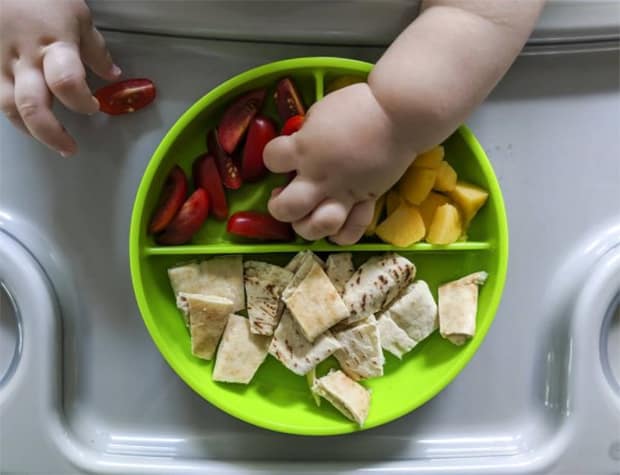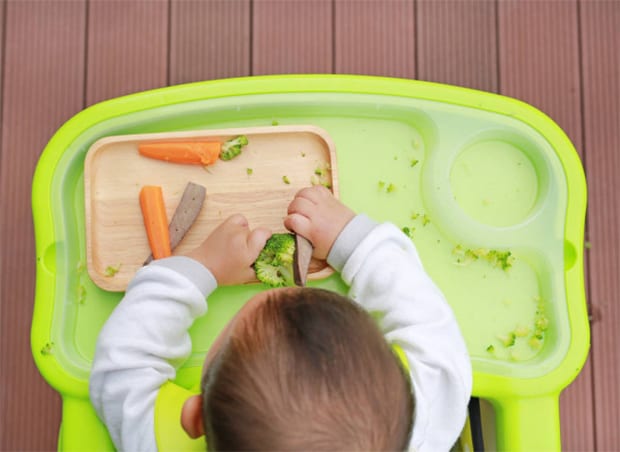Many parents struggle with feeding their babies solid foods at around 6 months old. They worry if they should start introducing solids earlier or later. Some believe that starting too early may cause problems like constipation while others think waiting until after 4 months might lead to issues such as reflux disease.

Your baby’s first solid food is a big milestone. It means they are eating more independently from mommy and daddy, which makes them less dependent on us for everything. But that doesn’t mean we should stop being involved in their diet. In fact, the best way to help your child transition into solids is by making sure he gets plenty of healthy nutrients while still getting all his nutrition through breast milk or formula.
When Can Babies Eat Table and Finger Foods?
The first thing to consider is what stage your child is at currently. If your baby is under 6 months old, then there isn’t any need to start introducing table foods yet. They will be able to suckle off of anything you put in front of them. However, if your baby is over 6 months old, then you should definitely begin teaching him/her how to use utensils. You don’t necessarily need to wait until he/she turns 1 year old either.
What Are Finger Foods?
Finger foods are small pieces of food that babies can pick up and eat using their fingers or a spoon. They may be soft like mashed banana or squash; they might have crunchy bits like apple slices; or they could even be hard like cheese cubes. The key thing about finger foods is that they’re easy for babies to hold in their hands and manipulate into the mouth. This makes them ideal for helping children learn how to feed themselves as well as encouraging independence!

Why Are Finger Foods Important?
Finger foods help babies learn how to eat by practicing chewing skills, developing their sense of taste and texture awareness as well as learning about food safety. They also provide a great opportunity for you to practice feeding techniques such as spooning, scooping and using utensils. In addition, it’s important to note that finger foods aren’t just good for kids who are ready to move onto table foods. Even those who haven’t started eating solids yet benefit from having these fun snacks available when hunger strikes.
What Finger Foods Should You Avoid Feeding Your Baby?
We know how tempting it might seem to give your little ones some of those crunchier snacks, but there are certain types of foods that should never be given to infants under 12 months old. Here are three things to avoid:
Raw Fruits and Vegetables
These contain lots of bacteria that can make your infant sick. Instead, opt for cooked veggies, fruit purees made with boiled water instead of juice, or frozen bananas cut into bite-sized chunks.
Hot Dogs
While hot dogs are perfectly safe to serve to older toddlers and preschoolers, they shouldn’t ever be fed to an infant because they can burn easily and pose choking hazards.
Chocolate Chips
Although chocolate chips are fine to offer to older kids, they can cause digestive issues in young babies due to their high sugar content. Stick to healthier options like dried cranberries, raisins, nuts and seeds.
How Do I Start Transitioning to Table foods?
The first step is to make sure you’ve got everything prepared ahead of time. Make sure there is plenty of room for your baby to sit down comfortably while eating. Also, make sure you have a high chair available, because once they begin sitting independently, they’ll probably prefer to do it themselves.

Introducing the Very First Table Food
This is an easy way to transition to table foods without having to worry about choking. This is a perfect example of why I say not to rush things. The peas and carrots were introduced slowly over several days so that he could practice his new skills. He was able to eat these vegetables all day long!
The next step after introducing peas and carrots is to try something like avocado. After this, you can move onto other fruits and veggies. Your goal here is to introduce one vegetable per meal. For instance, let’s say you’re serving chicken nuggets for dinner tonight. Instead of just giving your little guy some breaded chicken pieces, give him a piece of broccoli along with it. That way, he has both carbs and protein.
However, remember that even though you want to get your kids used to eating different types of foods, you shouldn’t force them to eat certain items. Let them choose what they want to eat. As long as they aren’t allergic to any particular item, they should be fine.
Do I Have to Wait Until Teeth Are Fully Grown?
Teeth usually come through around six months of age, but this varies between children. If your baby has not yet had any dental work done, he may need extra care during the first few weeks after starting to eat table food. You’ll want to watch him closely for signs of discomfort while chewing and biting into new foods.
In addition, keep track of when he starts teething. It might take longer than usual for him to develop strong enough jaw muscles to chew solid foods properly.
If your baby does experience pain from teething, you can ease the symptoms using natural remedies such as warm baths, massaging gums, applying cold compresses, etc. Be careful not to apply too much pressure to the area where the tooth is coming through, since this can cause bleeding. Then, call your pediatrician or dentist immediately if you notice any unusual behavior or changes in your child’s health.
Develop Healthy Habits Is Important
As soon as your baby starts chewing real food, he or she will develop healthy eating habits. By introducing new textures at an early age, you’ll encourage him or her to explore different tastes and flavors. You’re helping them build lifelong skills that will benefit them throughout life. at every stage of life, including infancy. By following these tips, you will help ensure your infant grows up happy and healthy.
Conclusion
In conclusion, we hope our tips on how to start transitioning to table food will help you prepare your family for the big change. Remember: don’t panic! Just follow my simple steps and you won’t go wrong. And most importantly, enjoy every moment of being a parent.










